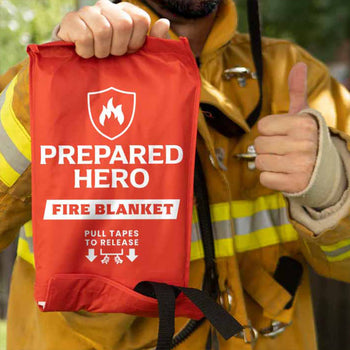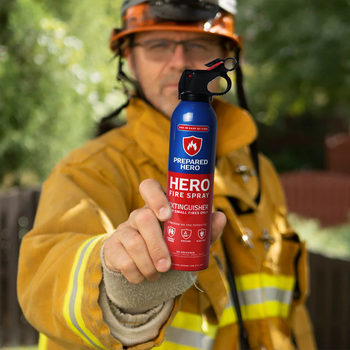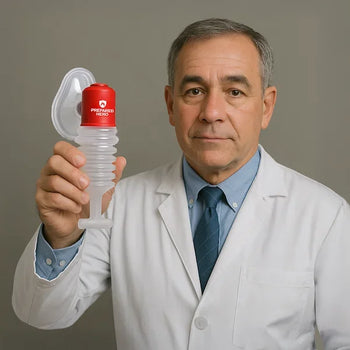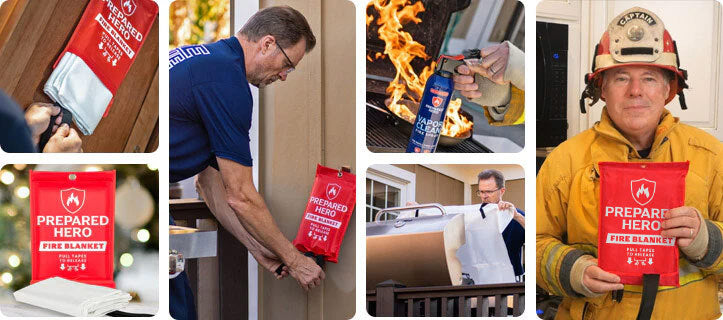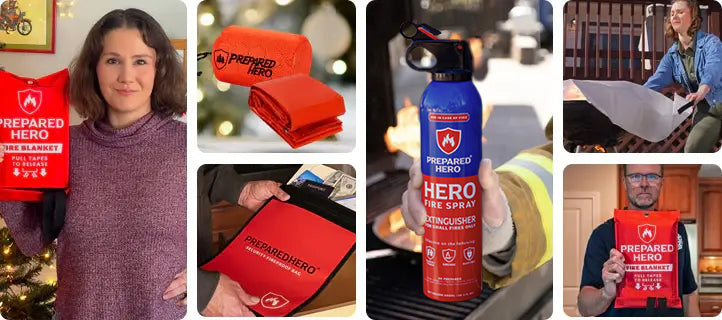Where you put your smoke detectors matters just as much as installing them. Proper placement makes sure they can detect...
Carbon monoxide is one of those things you don’t think about until it becomes a real danger. The problem? It can quietly build up in your home without you even knowing. In this guide, we’ll break down what carbon monoxide is, what it smells like, how it affects you, and how to detect it.
What Is Carbon Monoxide?

Carbon monoxide (CO) is a gas that forms when fuels like gas, wood, charcoal, or oil don’t burn completely. Potential sources of CO leaks include gas stoves, fireplaces, water heaters, car engines, and generators. The risk increases when they’re used in enclosed or poorly ventilated spaces. CO can also build up in detached garages, attached garages, basements, kitchens, or anywhere with poor airflow.
What makes carbon monoxide so dangerous is that it’s completely invisible. You can’t smell, see, or taste it. When you breathe it in, it sticks to your red blood cells and blocks oxygen from reaching your organs. Even small amounts can make you feel dizzy, weak, or nauseous. Plus, it’s easy to miss the warning signs because the symptoms feel like the flu.
Stay safe by making sure fuel-burning appliances are properly maintained and your home has carbon monoxide detectors. Find out more about carbon monoxide detector placement here. Carbon monoxide is sneaky, but with the right precautions, you can avoid the danger.
Is Carbon Monoxide Dangerous?
Carbon monoxide is dangerous. It’s called the “silent killer” because you can’t see, smell, or taste it. It sneaks into your home when fuel-burning appliances aren’t working properly or when a vent or chimney is blocked. Even running a car in a closed garage can cause deadly CO buildup.
The scary part is, you won’t even know you’re breathing it in until you start feeling sick. It can give you symptoms that feel just like the flu―headaches, nausea, dizziness, and fatigue. Some people even pass out or experience confusion, chest pain, and shortness of breath. It can be fatal if the gas keeps building up and you don’t get medical help.
Carbon monoxide poisoning kills more than 400 people each year in the United States. It also sends 100,000 people to emergency rooms per year. However, it's easily preventable. Just keep your appliances in good shape, don’t block vents and chimneys, and never use fuel-burning appliances indoors without proper ventilation. Most importantly, install carbon monoxide detectors all over your house. They can warn you before gas levels get dangerous. CO might not be visible to the naked eye, but you can keep your home safe with the right steps.
What Does Carbon Monoxide Smell Like?

Carbon monoxide doesn’t smell like anything because it has no smell. You can’t see it, taste it, or detect it with your senses. As a result, it can quietly build up in your home without warning signs, especially if you’re using fuel-burning appliances. You might think everything’s okay, but CO slips under the radar.
Unlike smoke or gas leaks that come with strong smells, CO buildup is odorless. The reason you can’t smell it has to do with its molecules. Carbon monoxide doesn’t interact with the receptors in your nose like other odor-causing gases do. Its molecular structure is simple and doesn’t trigger the sensors in your nose that tell your brain something stinks.
Since you can't rely on your senses, it’s crucial to install carbon monoxide detectors. They’re the only reliable way to know if CO is creeping into your space. Without them, you’re left guessing, which can be deadly. So, don’t wait for a smell. Trust the CO detectors instead.
Can a Carbon Monoxide Leak Lead to a Fire?
Yes, a carbon monoxide leak can lead to fire. Carbon monoxide is a highly flammable gas that ignites easily and burns quickly.
A huge leak or build-up can ignite. In particular, a house fire and carbon monoxide leak can spontaneously combust and, in rare cases, cause an explosion.
In addition, a carbon monoxide leak indicates that fuel-burning appliances like fireplaces, water heaters, and furnaces are malfunctioning. A fire or explosion might occur if this malfunction also involves natural gas or another fuel.
For instance, a furnace leaks carbon monoxide. If it also leaks methane, the gas can accumulate and, if ignited, start a fire or explosion. For these reasons, it’s best to keep fire blankets, fire sprays, and flame shields nearby.
How Can You Tell if There Is Carbon Monoxide in Your House?

You can’t smell or see carbon monoxide, so the best way to tell if it’s in your house is by using a carbon monoxide detector. It works like a smoke alarm and goes off when CO levels get too high. Make sure you have one on every floor of your home, especially near bedrooms and in the basement.
Test your detectors once a month to make sure they still work. Change the batteries every year or sooner if you hear that low-battery beep from your carbon monoxide detector. Also, don’t forget to replace the whole unit when it hits its expiration date.
You should also get your gas appliances checked by a professional every year. This includes furnaces, water heaters, and stoves. They could leak CO if they’re not working properly.
Sometimes, there are visual clues, too. Look out for yellow flames instead of blue on gas burners, black soot on appliances, or moisture buildup on windows. Stuffy air is also a red flag.
Plus, watch how you feel. If you or your family suddenly get dizzy, nauseous, or confused at home but feel better outside, that’s a big sign. Get fresh air and call for help right away. Carbon monoxide is sneaky, but with the right tools and habits, you can stay safe.
How Do I Know If I’m Smelling Carbon Monoxide?
If you think you're smelling carbon monoxide, you’re probably not. The gas has smell, taste, or color, so your nose won’t help you detect it. That’s what makes it so dangerous.
However, there are smells you might notice that could point to a related problem. For example, natural gas leaks often have a sulfur or rotten egg smell because gas companies add that odor to warn people. If you smell something like that, it might mean there's a gas leak, and a CO leak could come with it.
You might also catch a whiff of something burning, smoky, or like car exhaust. This could be a warning sign from a malfunctioning appliance that’s not burning fuel properly and may be releasing CO.
Aside from smells, look for other clues like yellow flames on your gas stove (they should be blue), soot around burners, or appliances that keep turning off. These can all point to trouble.
But here’s the real answer: the only way to know if CO is around is with a carbon monoxide detector. It’s the one thing that can actually detect it and save your life.
What Are Two Warning Signs of Carbon Monoxide Poisoning?

The two main warning signs of carbon monoxide (CO) poisoning are headache and dizziness. These symptoms show up early and can feel like the flu, except there’s no fever. That’s what makes CO so tricky. You might think you’re just coming down with something, but it could be something much more serious.
Carbon monoxide is a toxic gas that you can’t see, smell, or taste. It messes with your body’s ability to use oxygen, which can cause serious damage to your brain, heart, and other organs. If you start feeling dizzy or get a sudden headache, especially when you’re indoors or near a fuel-burning appliance, that’s a red flag.
Other symptoms can follow, like weakness, nausea, confusion, or even fainting. If more than one person in your home starts feeling sick at the same time, that’s another warning sign. Don’t wait; get everyone outside into fresh air and call 911 right away.
A working carbon monoxide detector is the best way to catch CO before it becomes a serious problem.
Will Opening a Window Stop Carbon Monoxide?
Opening a window can help lower carbon monoxide (CO) levels by letting in fresh air, but it’s not enough to solve the problem. It might reduce the gas a little by diluting it, but the danger remains if the source of the CO, like a faulty heater or stove, is still running.
Fresh air helps move the gas out, but don’t count on windows alone to keep you safe. If the CO is coming from something inside your house, the leak needs to be found and fixed. In rare cases, opening a window makes things worse if the outdoor air has high CO levels (like near a running car or generator).
Bottom line: if you suspect CO poisoning, don’t waste time. Get out of the house right away, open windows on your way if you can, and call emergency services. Once everyone’s safe, have a professional check your appliances.
How Do You Check for Carbon Monoxide Without a Detector?

You can’t actually see or smell the gas, so detecting carbon monoxide at home without a detector is tricky. But there are warning signs that might hint that something’s wrong.
Look around your gas appliances. Do you see soot, stains, or smoke building up? That’s not normal. If the pilot light keeps blowing out or the flame turns yellow or orange (instead of blue), that could mean poor combustion, which can lead to CO leaks.
Also, pay attention to how your home feels. Is the air stale or stuffy? Are your windows getting super foggy where the heaters are? That might be a red flag. And if you or anyone in your home feels dizzy, weak, nauseous, or like you have the flu, but it clears up when you leave, that could be CO poisoning.
Even with these signs, nothing beats having a carbon monoxide detector. It’s the only way to be sure. If you even suspect a leak, get out, stay out, and call for help right away.
What’s the Most Common Household Thing to Cause a Carbon Monoxide Leak?
The most common source of carbon monoxide leaks at home is fuel-burning appliances that aren’t working right or aren’t properly ventilated. We’re talking gas stoves, water heaters, furnaces, and fireplaces. If they don’t burn fuel completely or the fumes can’t escape, CO can build up fast.
Chimneys and furnaces that leak or have blockages are also big offenders. And if there’s poor ventilation, gases can backdraft into your home instead of venting outside. Even running a car in an attached garage can fill your house with CO, especially if the door is closed.
Other risky sources? Portable generators, gas-powered tools, and indoor use of camping stoves. Basically, any carbon-based fuel—gasoline, propane, wood, or charcoal—can produce carbon monoxide if it doesn’t burn completely. It’s a sneaky gas that can seriously mess with your oxygen levels. Always keep appliances in good shape and make sure your space is ventilated.
Conclusion
Carbon monoxide is sneaky, silent, and dangerous, but you can prevent it from harming you and your family. Since you can’t smell or see it, your best defense is a working carbon monoxide detector and regular appliance checks.
Pay attention to warning signs, trust your gut if you feel off at home, and never ignore symptoms like headaches or dizziness. With the right tools and habits, you can protect your space and keep everyone safe without second-guessing. Stay safe, hero!


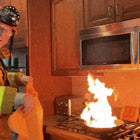 Fire
Fire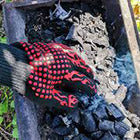 Safety
Safety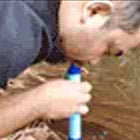 Survival
Survival Protection
Protection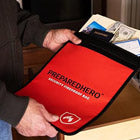 New
New
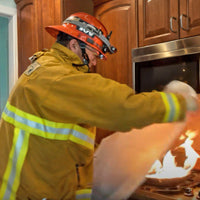 Fire
Fire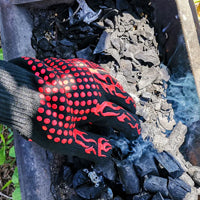 Safety
Safety Survival
Survival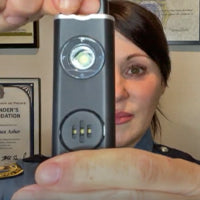 Protection
Protection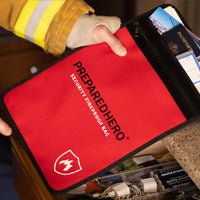 New
New
